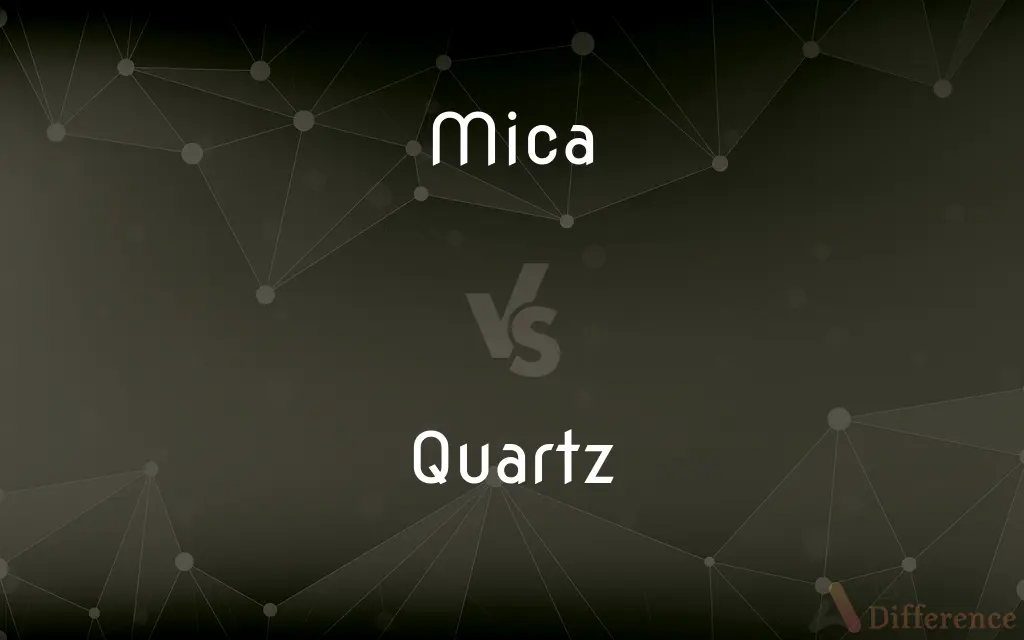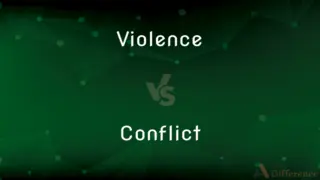Mica vs. Quartz — What's the Difference?
By Tayyaba Rehman & Maham Liaqat — Updated on March 8, 2024
Mica is a group of silicate minerals known for its layered structure and perfect cleavage, enabling thin sheets separation, while quartz is a hard, crystalline mineral composed of silica, known for its durability and lack of cleavage.

Difference Between Mica and Quartz
Table of Contents
ADVERTISEMENT
Key Differences
Mica refers to a group of minerals characterized by their sheet-like structure and ability to be split into thin, flexible sheets. This unique property is due to its perfect cleavage, which allows it to be used in a variety of applications, such as electrical and thermal insulators. On the other hand, quartz is recognized for its hard, crystalline structure, composed primarily of silicon dioxide. Unlike mica, quartz does not have cleavage, which contributes to its high durability and resistance to weathering, making it a popular choice for jewelry and hardstone carvings.
The composition of mica includes a variety of elements such as potassium, aluminum, magnesium, and iron, which contribute to its diverse range of colors and types. Micas can be found in colors ranging from clear to black, including vibrant hues such as purple, pink, green, and gold. Whereas quartz, though primarily made of silica, can also appear in various colors due to impurities. These colors include clear, white, pink (rose quartz), purple (amethyst), and black (smoky quartz), among others.
Mica's excellent insulating properties, both electrical and thermal, along with its resistance to high temperatures, make it valuable in the electrical industry, for manufacturing insulating materials, and in cosmetics for its reflective properties. Quartz, on the other hand, is prized for its physical and optical properties, such as piezoelectricity (which is useful in electronics and timekeeping devices) and its use in making glass and ceramics, reflecting its versatility across different industries.
In terms of formation, mica minerals typically form in metamorphic and igneous rocks through the process of crystallization from magma or the alteration of other minerals under heat and pressure. This results in their layered structure. Quartz also forms from crystallization of magma but can develop in a wider range of geological environments, including hydrothermal veins and as a component of sedimentary rocks, highlighting its widespread occurrence in the Earth's crust.
The commercial use of mica has evolved over time, with significant applications in electronics due to its insulating properties, and in the beauty industry for its shimmering effect in makeup. Quartz has also seen diverse applications, not only in jewelry and decorative items but also in the construction industry, particularly in the form of engineered stone for countertops, and in technology, especially for its piezoelectric properties used in quartz watches and oscillators.
ADVERTISEMENT
Comparison Chart
Composition
Silicate minerals with potassium, aluminum, magnesium, iron.
Silicon dioxide (SiO2).
Structure
Layered, sheet-like, perfect cleavage.
Crystalline, hard, lacks cleavage.
Color Variations
Clear to black, including purple, pink, green, gold.
Clear, white, pink, purple, black, depending on impurities.
Uses
Electrical insulators, thermal insulation, cosmetics.
Jewelry, electronics, glass and ceramics manufacturing.
Formation
Metamorphic and igneous rocks, crystallization from magma.
Crystallization of magma, hydrothermal veins, sedimentary rocks.
Compare with Definitions
Mica
Displays a wide range of colors due to its composition.
The green mica added a vibrant hue to the natural stone collection.
Quartz
A hard, crystalline mineral made of silicon dioxide.
The quartz countertop was admired for its durability and aesthetic appeal.
Mica
Used in cosmetics for its reflective properties.
The eyeshadow's shimmer was due to finely ground mica.
Quartz
Exhibits piezoelectric properties useful in electronics.
Quartz crystals are crucial in the functioning of modern watches.
Mica
A group of sheet-like silicate minerals with perfect cleavage.
The thin sheets of mica were used as electrical insulators.
Quartz
Lacks cleavage, contributing to its strength and durability.
Quartz's resilience makes it suitable for jewelry that withstands daily wear.
Mica
Known for its flexibility and ability to split into thin sheets.
Mica's unique structure makes it ideal for thermal insulation.
Quartz
Can appear in various colors depending on impurities.
The amethyst, a type of quartz, was valued for its deep purple color.
Mica
Valuable in the electrical industry for insulation.
Mica sheets are essential components in high-temperature insulation.
Quartz
Widely used in glass and ceramics manufacturing.
Quartz sand is a primary ingredient in making glass.
Mica
Micas ( MY-kəz) are a group of minerals whose outstanding physical characteristic is that individual mica crystals can easily be split into extremely thin elastic plates. This characteristic is described as perfect basal cleavage.
Quartz
Quartz is a hard, crystalline mineral composed of silica (silicon dioxide). The atoms are linked in a continuous framework of SiO4 silicon-oxygen tetrahedra, with each oxygen being shared between two tetrahedra, giving an overall chemical formula of SiO2.
Mica
A shiny silicate mineral with a layered structure, found as minute scales in granite and other rocks, or as crystals. It is used as a thermal or electrical insulator.
Quartz
A very hard mineral composed of silica, SiO2, found worldwide in many different types of rocks, including sandstone and granite. Varieties of quartz include agate, chalcedony, chert, flint, opal, and rock crystal.
Mica
Any of a group of chemically and physically related aluminum silicate minerals, common in igneous and metamorphic rocks, characteristically splitting into flexible sheets used in insulation and electrical equipment.
Quartz
(mineral) The most abundant mineral on the earth's surface, of chemical composition silicon dioxide, SiO2. It occurs in a variety of forms, both crystalline and amorphous. Found in every environment.
Mica
(mineral) Any of a group of hydrous aluminosilicate minerals characterized by highly perfect cleavage, so that they readily separate into very thin leaves, more or less elastic.
Quartz
Crystal meth: methamphetamine hydrochloride.
Mica
The name of a group of minerals characterized by highly perfect cleavage, so that they readily separate into very thin leaves, more or less elastic. They differ widely in composition, and vary in color from pale brown or yellow to green or black. The transparent forms are used in lanterns, the doors of stoves, etc., being popularly called isinglass. Formerly called also cat-silver, and glimmer.
Quartz
A form of silica, or silicon dioxide (SiO2), occurring in hexagonal crystals, which are commonly colorless and transparent, but sometimes also yellow, brown, purple, green, and of other colors; also in cryptocrystalline massive forms varying in color and degree of transparency, being sometimes opaque.
Mica
Any of various minerals consisting of hydrous silicates of aluminum or potassium etc. that crystallize in forms that allow perfect cleavage into very thin leaves; used as dielectrics because of their resistance to electricity
Quartz
Colorless glass made of almost pure silica
Quartz
A hard glossy mineral consisting of silicon dioxide in crystal form; present in most rocks (especially sandstone and granite); yellow sand is quartz with iron oxide impurities
Common Curiosities
What are the uses of mica?
Mica is used for electrical and thermal insulation, and in cosmetics for its shimmering effects.
What is mica?
Mica is a group of silicate minerals known for its flexible, sheet-like structure and perfect cleavage, allowing for thin sheet separation.
What is quartz?
Quartz is a hard, crystalline mineral composed of silicon dioxide, known for its durability and lack of cleavage.
What are the uses of quartz?
Quartz is used in jewelry, electronics, and in the manufacturing of glass and ceramics.
How do mica and quartz form?
Mica forms in metamorphic and igneous rocks, while quartz can form in a broader range of environments, including sedimentary rocks.
Why is quartz used in timekeeping devices?
Its piezoelectric properties, which can convert mechanical stress into electrical signals and vice versa, make it ideal for precision in timekeeping devices.
How does mica's composition affect its color variations?
The presence of different elements such as potassium, aluminum, magnesium, and iron contributes to mica's wide range of colors.
Can quartz be found in different colors?
Yes, quartz can appear in various colors like clear, white, pink, purple, and black, depending on impurities.
What makes mica unique in terms of structure?
Its layered, sheet-like structure with perfect cleavage allows for the separation of thin, flexible sheets.
How do mica and quartz differ in composition?
Mica contains a variety of elements like potassium and aluminum, while quartz is primarily silicon dioxide.
Why is mica valued in the electrical industry?
Its excellent insulating properties and resistance to high temperatures make it valuable for manufacturing insulating materials.
What role does quartz play in the construction industry?
Quartz is often used in the form of engineered stone for countertops and other decorative elements due to its durability and aesthetic appeal.
Is quartz suitable for use in jewelry?
Yes, due to its hardness and durability, quartz is a popular choice for jewelry.
How do the properties of mica benefit the cosmetics industry?
Mica's reflective properties give a shimmering effect to makeup products like eyeshadows and highlighters.
Share Your Discovery

Previous Comparison
Violence vs. Conflict
Next Comparison
Pretense vs. DisguiseAuthor Spotlight
Written by
Tayyaba RehmanTayyaba Rehman is a distinguished writer, currently serving as a primary contributor to askdifference.com. As a researcher in semantics and etymology, Tayyaba's passion for the complexity of languages and their distinctions has found a perfect home on the platform. Tayyaba delves into the intricacies of language, distinguishing between commonly confused words and phrases, thereby providing clarity for readers worldwide.
Co-written by
Maham Liaqat















































